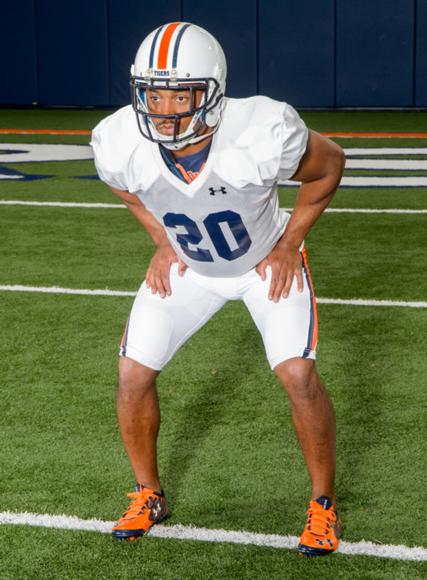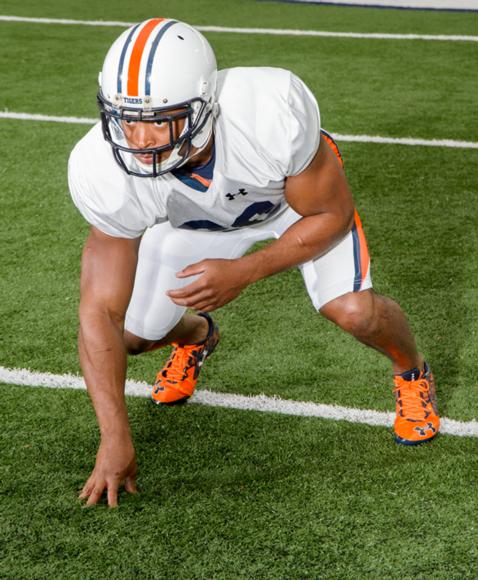Two-Point and Three-Point Stances
This is an excerpt from Complete Running Back by Tim Horton.
Two-Point Stance
In the two-point stance (figure 2.2), or up stance, stand with both feet on the ground and your hands resting on your thighs. The two-point stance is the most common stance used by running backs today. The two-point stance gives you a better view of the defensive structure, or defensive movement. This stance is used most frequently in the I-formation and with teams that use the shotgun.

Two-point stance.
Here are key coaching points for the two-point stance:
- Feet are parallel with weight on inside balls of feet. Toes are pointed straight ahead.
- Knees are cocked inside in line with insides of feet and ankles.
- Hands are above knees.
- Head and shoulders are square to line of scrimmage and not in front of knees.
- Back is straight and hips are low, as if you're starting to sit on a chair. Bend at the knees instead of bending forward at the waist.
- Weight is evenly distributed to enable you to start in either direction without false stepping.
Three-Point Stance
In the three-point stance (figure 2.3), or down stance, you put your right or left hand on the ground, similar to an offensive lineman. The three points are one hand and both feet on the ground. Generally, this stance is used for blocking and allows you to hit on the rise. A down stance is most popular for a fullback in the I-formation or in a split-back formation.

Three-point stance.
Here are key coaching points for the three-point stance:
- Feet are shoulder-width apart, toes pointed straight upfield, feet staggered, with the toes of one foot even with the heel of the other. Weight is evenly distributed on the inside balls of the feet so feet can be used like starting blocks.
- Knees are cocked inside, in line with the feet and ankles, and bent enough to be able to flatten the back.
- Shoulders are squared to the line of scrimmage, parallel to the ground, and extended over toes.
- Head and eyes are slightly raised and looking straight ahead enough to get a presnap look. Look out of the tops of your eyes. Don't give away the play by staring in the direction you will go.
- Up arm is bent at the elbow, with the forearm resting just outside the knee and the hand loosely fisted in a relaxed position. Down hand (usually the dominant hand) reaches out from the shoulder to a point even with the tip of the helmet and on a line just inside the near foot. This arm and hand provide balance, not weight support. The length of the reach can vary according to the forward weight needed to execute a particular assignment.
- Fingers on the down hand create a five-finger bridge.
- Weight is evenly distributed so you can start in any direction with ease. Be certain that you don't give away the play by leaning, looking, or changing your stance.
Learn more about Complete Running Back.
More Excerpts From Complete Running BackSHOP

Get the latest insights with regular newsletters, plus periodic product information and special insider offers.
JOIN NOW


